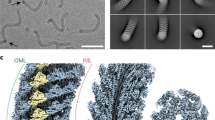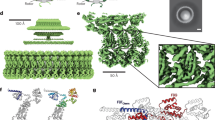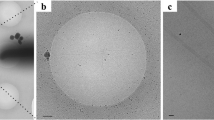Abstract
ALTHOUGH bacterial flagella can assume various helical configurations1–3, the ‘normal’ and ‘curly’ configurations are encountered most frequently in nature. In Salmonella, normal and curly flagella have helical pitches of about 2.3 and 1.1 µm, respectively4. Macnab and Koshland5 observed that normal flagella of living Salmonella were left-handed helical filaments, as shown for Proteus and Bacillus6. Flagella with this handedness and rotating counterclockwise (looking in the direction of travel), would cause helical waves to propagate distally and provide forward thrust7–9. Normal flagella can transform reversibly into the curly type when physiological conditions, such as pH, are varied10,11: this has been termed biplicity. Asakura et al.12, using Salmonella strain SJ670 and others, found that reconstituted flagellar filaments also could be transformed reversibly, although they could not control this transformation completely. SJ670 is a motile strain that produces normal flagella. On the other hand, the mutant SJ30 isolated by lino13 produces flagella which are stable in the curly configuration in various conditions. The mutation is in the structural gene for the flagellar protein subumit, flagellin, and the mutant cannot swim normally tout appears to tumble continuously. Now, using SJ670 and SJ30, we have found that, whereas the normal configuration of flagella is a left-handed helix, the curly configuration is a right-handed helix.
This is a preview of subscription content, access via your institution
Access options
Subscribe to this journal
Receive 51 print issues and online access
$199.00 per year
only $3.90 per issue
Buy this article
- Purchase on Springer Link
- Instant access to full article PDF
Prices may be subject to local taxes which are calculated during checkout
Similar content being viewed by others
References
Leifson, E. Atlas of bacterial flagellation (Academic, New York and London, 1960).
Iino, T., Bact., Rev., 33, 454–475 (1969).
Asakura, S., Adv. Biophys., 1, 99–155 (1970).
Pijper, A., Neser, M. L., and Abraham, G., J. gen. Microbiol., 14, 371–380 (1956).
Macnab, R. M., and Koshland, D. E., J. molec. Biol., 84, 399–406 (1974).
Weibull, C., Ark. Kemi., 1, 573–575 (1949).
Silverman, M., and Simon, M., Nature, 249, 73–74 (1974).
Larsen, S. H., Reader, R. W., Kort, E. N., Tso, W.-W., and Adler, J., Nature, 249, 74–77 (1974).
Berg, H. C., Nature, 249, 77–79 (1974).
Pijper, A., Ergebn. Mikrobiol. ImmunForsch. exp. Ther., 30, 37–91 (1957).
Leifson, E., Carhart, S. R., and Fulton, M., J. Bact., 69, 73–82 (1955).
Asakura, S., Eguchi, G., and Iino, T., J. molec. Biol., 16, 302–316 (1966).
Iino, T., J. gen. Microbiol., 27, 167–175 (1962).
Asakura, S., and Iino, T., J. molec. Biol., 64, 251–268 (1972).
Asakura, S., and Oosawa, F., J. Polymer Sci., 33, 183–192 (1958).
Author information
Authors and Affiliations
Rights and permissions
About this article
Cite this article
SHIMADA, K., KAMIYA, R. & ASAKURA, S. Left-handed to right-handed helix conversion in Salmonella flagella. Nature 254, 332–334 (1975). https://doi.org/10.1038/254332a0
Received:
Revised:
Issue Date:
DOI: https://doi.org/10.1038/254332a0
This article is cited by
-
Torque transmission mechanism of the curved bacterial flagellar hook revealed by cryo-EM
Nature Structural & Molecular Biology (2019)
-
Right-handed rotation of an actin filament in an in vitro motile system
Nature (1993)
-
Movement of microorganisms in viscous environments
Nature (1979)
-
Construction of bacterial flagella
Nature (1975)
Comments
By submitting a comment you agree to abide by our Terms and Community Guidelines. If you find something abusive or that does not comply with our terms or guidelines please flag it as inappropriate.



